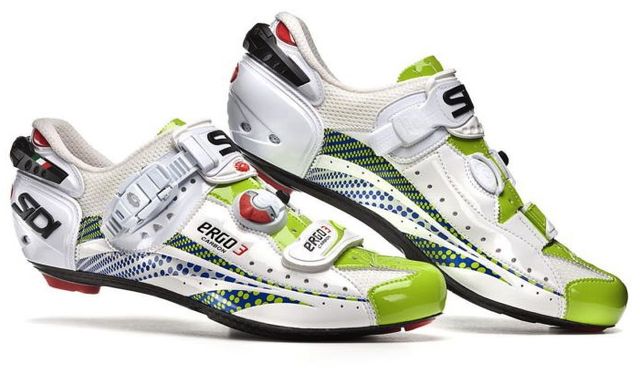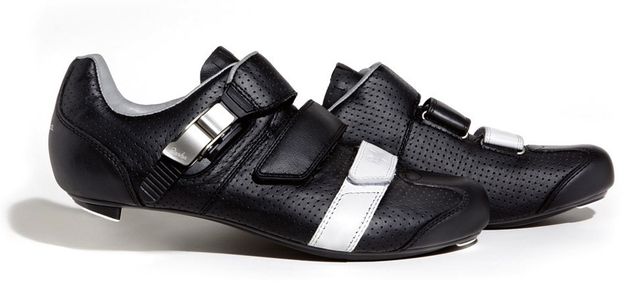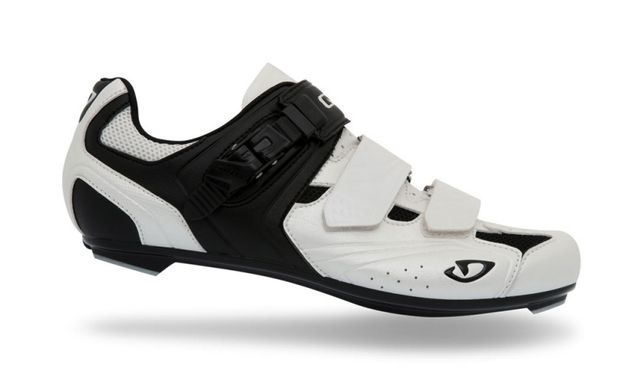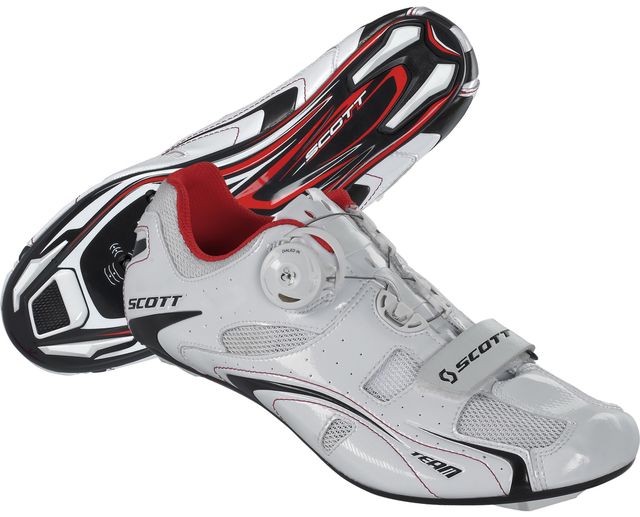With gran fondo season kicking off around the country and glorious spring already giving way to premature summer heat, it's time to get kitted up for riding season. We've been testing stacks of gear for the past few months and will bring you a series of head-to-head reviews in coming weeks, starting with road bike cleats.
Though we tend to obsess about saddles and shorts when considering comfort on the bike (and those things are imminently important), a great-fitting shoe is nearly as critical. Here are our top picks of the dozen or so we've tried this year.

Sidi Ergo 3, Liquigas Special Edition聽($500)
Debuted at the Giro d鈥橧talia by Ivan Basso and team Liqiugas-Cannondale, these new Ergo 3s are sure to polarize with their flashy looks. If you like them (I do!), 聽get 鈥榚m quick as Sidi will only sell 50 pairs in the United States and you'll be relegated to the (the same shoe in different colorways) when these are gone. But this is much more than just a fashion-forward race cleat.
The carbon sole is stiff without being brutal, and though it鈥檚 not the thinnest on the market, stack height is still plenty low. More importantly, the new sole vent system is perhaps the best out there: not only does it provide lots of airflow for hot conditions, but it can also be closed off for winter riding. Sidi鈥檚 closure system鈥攁 ratcheting buckle up top, a spin-lock dial in the middle, and Velcro with built-in plastic ribbing for added hold at the bottom鈥攊s incredibly adjustable and holds so firm that once dialed, I never had to retighten, even on full-day rides. There鈥檚 also a trick heel clamp system: A small screw allows you to ratchet the fit on your Achilles for comfort and zero lift or slippage. And as always with Sidis, build quality is impeccable.
Bottom Line: Given all the fit fine-tuning, the Ergo 3 is ideal for pros and anyone who spends lots of time on the bike and values comfort. Fit is average to narrow. The eye-watering cost is the only drawback, but the Ergo 3 is more affordable than the price tag suggests as Sidi鈥檚 high-quality construction means the shoe should outlast multiple pairs in other brands.

Rapha Grand Tour聽($450)
The most chic clothier in cycling entered the shoe market this spring with just one model, these sophisticated all-leather cleats built in collaboration with Giro and Ecco. The Easton EC90 SLX high-modulus carbon outsole is the same one used on Giro鈥檚 top-tier Prolights, and it鈥檚 my favorite out there because of its incredibly thin profile. (I had to lower my saddle they鈥檙e so slim.) The insole is a cork version of Giro SuperNatural Fit footbeds, a trick design that lets you choose between three arch heights for maximum comfort. I run a different size in each shoe, which has dramatically cut down on the foot cramps I鈥檝e experienced in other shoes.
The similarities to the Prolights stop there. The perforated Yak leather upper gives the such a plush, slipper-like feel that I took them straight from the box out on a six-hour ride and never had even the slightest foot discomfort. Rapha says the thick, cushy leather will meld to your foot and weather beautifully over time, and I believe it as mine seem to be getting even more comfy as the months go by. The styling reminds me of my first pair of Duegi cleats 20-some years ago鈥攖he single contrast strap is intended to evoke a toe clip鈥攖hough it鈥檚 not a look that pairs well with flashy race kits.
Bottom Line: Though Rapha calls them the Grand Tour, with a high-volume fit and relatively stout weight, these shoes lend themselves more to touring than racing. And while the price is sky high, it鈥檚 in line with other brand鈥檚 top-shelf shoes. If the Grand Tour fits, and you want a classy cleat that will last a decade (both in terms of performance and style), these are worth considering.

Giro Apeckx听($150)
Giro jumped into the shoe market two years ago with a small line of high quality and mostly high-end shoes that had surprisingly dialed-in last shapes and smart features (like the ultra-thin soles and well-designed footbeds). This year, they鈥檝e filled out the line with a handful of models that benefit from technology trickle-down in more wallet-friendly price points. One of the best is , a three-strap shoe that far outperforms the sport category its price tag suggests.
I quite like the white-and-black contrast model, but for those who can鈥檛 rock the Storm Trooper look there鈥檚 a tamer silver-on-black version. The microfiber upper isn鈥檛 as thin and supple as the material used in Giro鈥檚 higher-end models, but it鈥檚 still softer and more comfortable than the plasticky materials that feature in many shoes at this price. Same with the nylon sole: It鈥檚 thicker than the Easton carbon used in the top-shelf shoes, but it鈥檚 still fairly thin and admirably stiff鈥攐ne of the stiffest of any non-carbon sole I鈥檝e tried. The Apeckx is built on the same last as Giro鈥檚 best shoes, so the fit is great (medium to low volume), and the company has leveraged its considerable manufacturing heft to include features (such as the high-quality replaceable buckle) often not available at this price.
Bottom Line: The Apeckx is a top-notch entry for new cyclists, sport riders, and anyone on a budget. It聽doesn't have the subtlety of a premium race cleat, but it rides well and feels surprisingly good for the price. I miss Giro's SuperNatural Fit footbed, which you can get after market, though at $50 it might be better to upgrade to the Trans ($225).

Scott Road Team Boa听($150)
I tend to shy away from shoes not built by companies dedicated to footwear, but won me over with its high performance-to-value ratio. The Boa closure and vented sole are features normally reserved for much more expensive shoes, and indeed, these cleats are a few grams lighter than Scott's much pricier Road Premium model (and pretty much anything else on the market I've tried).聽The lack of weight is noticeable: These shoes feel like toys in your hand, and on the bike it seems聽like you're wearing almost nothing at all.聽The combination of the Boa and single Velcro strap does a solid job of clamping down the fit without creating hotspot鈥攁 good thing since the wider forefoot meant I needed to really cinch these down. I did find that the Boa dial slipped a bit from time to time so I occasionally had to re-ratchet the tightness.
Though they're exceedingly light and fast, these shoes aren't for everyone. I found the nylon sole to be mercilessly stiff, which is great for power transfer but not ideal for comfort. After several hours in the shoes I often had to loosen the fit to give my tired dogs a break. That unrelenting feel derives partly from the super lightweight nature of the shoe. With聽so little material in the upper and midsole, the Road Team Boa lacks the substance and comfort of other high-end shoes. And though I didn't have any problems in the few months I wore them, I do worry that these shoes would break down quicker than others.
Bottom Line: The Road Team Boas are as light and minimal as a high-end carbon race bike, and they feel nearly as jarring. Though they wouldn't be my choice for long days in the saddle or for new riders who aren't used to super-stiff shoes, they are an amazing value for racers searching for every weight advantage.
鈥擜aron Gulley